The Greatest Debut Albums of the 1970s
Let's explore the gems by everyone from Van Halen to Patti Smith to Meat Loaf to the New York Dolls.
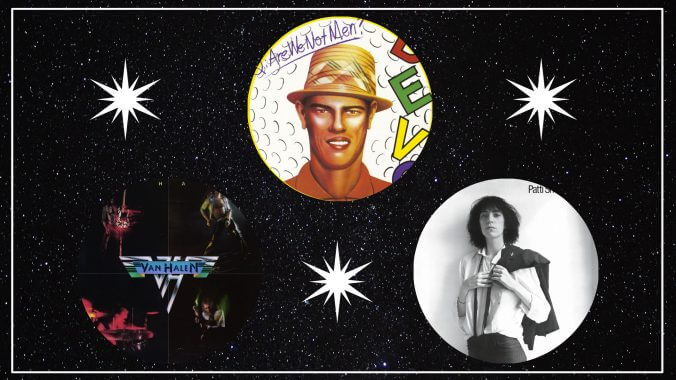
Last month, we ranked the 100 greatest debut albums of the 21st century. Now, we’re setting our sights on the rest of modern music. For the remainder of 2023, the Paste music team will be traversing a half-century of history. Each Saturday, we will be ranking the best debut albums from every decade between the 1960s and 1990s—culminating in a full 20th Century list and then, dare I say it, a greatest debut albums of all time ranking that spans from the 1950s until now.
In my opinion, ranking the 1960s was the easiest of the bunch. This past week, the music team went back and forth on what to include in our 1970s chapter, and some really great records were, unfortunately, left behind. There was such a huge pool of work to choose from that any way we went was going to ruffle some feathers. But, you can’t go wrong with any of the Top 25 that we’ve picked. Don’t miss what comes of the Reagan years next Saturday, though, as the worlds of alt-rock, hair metal and chart-topping pop will be duking it out for the top spot. Right now, however, may we present you with our picks for the 25 greatest debut albums of the 1970s—featuring Van Halen, Blondie, Devo, Patti Smith, Talking Heads and many more. —Matt Mitchell, Paste Music Editor
On the Outside Looking In: Funkadelic: Funkadelic; Kate Bush: The Kick Inside; The Police: Outlandos d’Amour; Elvis Costello: My Aim is True; The Residents: The Residents; Steely Dan: Can’t Buy a Thrill; Bruce Springsteen: Greetings From Asbury Park, NJ; Weather Report: Weather Report; Roxy Music: Roxy Music
25. Lynyrd Skynyrd: (Pronounced ‘Lĕh-‘nérd ‘Skin-‘nérd) (1973)
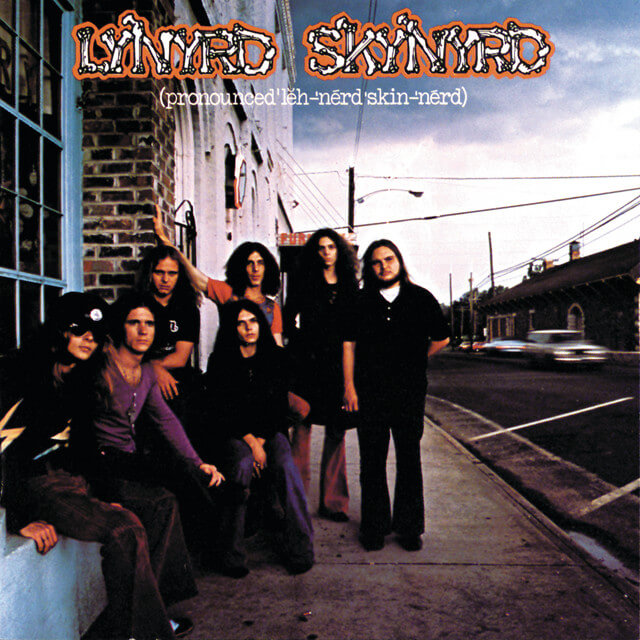 (Pronounced ‘Lĕh-‘nérd ‘Skin-‘nérd) introduced the world to both the quintessential Southern rock band at the height of its powers and the epic “Free Bird,” empowering decades of slow-witted would-be hecklers with the ability to provoke audible groans from any audience throughout the world. More importantly the album features two of the absolute greatest rock songs of all time, “Simple Man” and the elegiac “Tuesday’s Gone.” —Garrett Martin
(Pronounced ‘Lĕh-‘nérd ‘Skin-‘nérd) introduced the world to both the quintessential Southern rock band at the height of its powers and the epic “Free Bird,” empowering decades of slow-witted would-be hecklers with the ability to provoke audible groans from any audience throughout the world. More importantly the album features two of the absolute greatest rock songs of all time, “Simple Man” and the elegiac “Tuesday’s Gone.” —Garrett Martin
24. Vashti Bunyan: Just Another Diamond Day (1970)
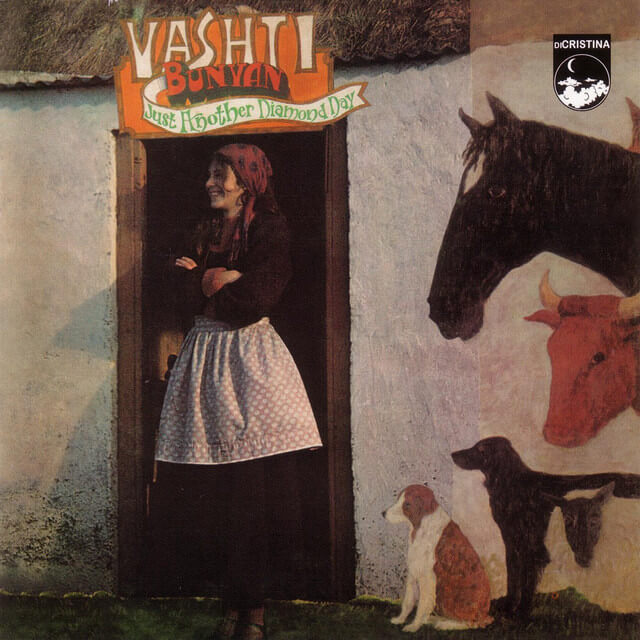
After two years of traversing the Scottish hills by horse and carriage, Vashti Bunyan had more than enough material to write an album. She was a bit of a disciple, following the promise of a communal living space led by folk legend Donovan. She never found Donovan’s commune. Rather, she stumbled upon a divine sort of inspiration that allowed her to record Just Another Diamond Day in just three days of studio time in 1969. What ensued was nothing short of magic. With just her voice and strings, Bunyan became a world in herself. Her voice is as diaphanous as it is dense, with layers of vibrato and naturalism. Her compositions are simple; Joe Boyd’s production pulls each note as taut as it can go before it breaks. From tree to timbre, Bunyan’s debut is about as utterly captivating as music could get.
Vashti Bunyan’s first album was also the only one she would release for 35 years. After her debut was met with little excitement in the months and years following its release, Bunyan disappeared again, this time for good from the music world. She had a newborn child to care for, and after selling the few hundred copies of Diamond Day that she pressed, she moved herself into a cottage with her friends in the Incredible String Band. Over the next three decades, she migrated around the United Kingdom, raised her three children, and didn’t record any new music. Simultaneously, her first record began gaining popularity. Around the turn of the century, it garnered a new excitement among artists and critics interested in folk’s minimalist intimacy as well as its potential for oddball experimentation, the likes of Joanna Newsom and Diane Cluck. In 2000, the album was reissued on CD and, today, it has more than earned its space as a bona fide classic—an exercise in fully engulfing listener consciousnesses. . —Madelyn Dawson
23. Gram Parsons: GP (1973)
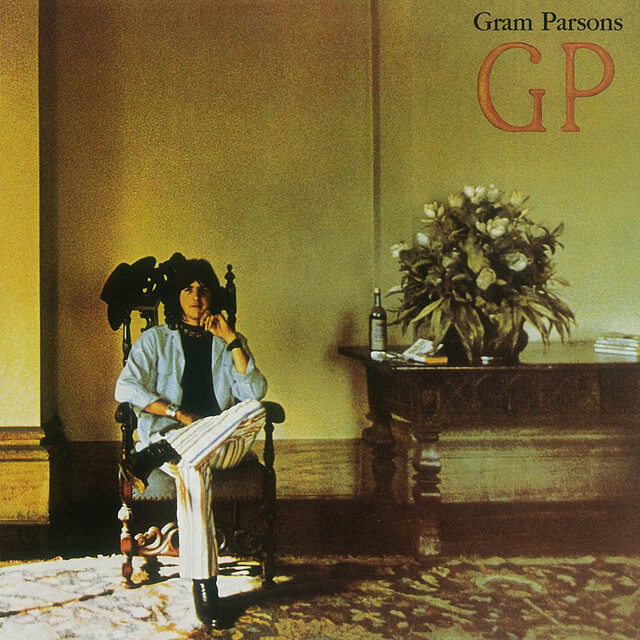 By the time Gram Parsons released his debut solo album, he’d already been a central figure in southern rock ‘n’ roll. He’d started the band International Submarine Band, had been a pivotal building block in the Byrds’ best album (Sweetheart of the Rodeo) and co-founded The Flying Burrito Brothers all between 1968 and 1970. Fast-forward three years, and he, finally, made a record under his own name—and it’s a pretty damn terrific one. GP is 11 of the most soulful, poetic country rock songs this side of Sun Records. It introduced the world to the eternal greatness of Emmylou Harris while solidifying Parsons’ legacy altogether. “She” and “A Song for You” and “That’s All It Took” are reflective, compassionate and beautiful standouts, while “Streets of Baltimore” endures as a country staple. Parsons would pass away not even 11 months later, but GP made sure he wouldn’t be forgotten. —Matt Mitchell
By the time Gram Parsons released his debut solo album, he’d already been a central figure in southern rock ‘n’ roll. He’d started the band International Submarine Band, had been a pivotal building block in the Byrds’ best album (Sweetheart of the Rodeo) and co-founded The Flying Burrito Brothers all between 1968 and 1970. Fast-forward three years, and he, finally, made a record under his own name—and it’s a pretty damn terrific one. GP is 11 of the most soulful, poetic country rock songs this side of Sun Records. It introduced the world to the eternal greatness of Emmylou Harris while solidifying Parsons’ legacy altogether. “She” and “A Song for You” and “That’s All It Took” are reflective, compassionate and beautiful standouts, while “Streets of Baltimore” endures as a country staple. Parsons would pass away not even 11 months later, but GP made sure he wouldn’t be forgotten. —Matt Mitchell
22. Sex Pistols: Never Mind the Bollocks, Here’s the Sex Pistols (1977)
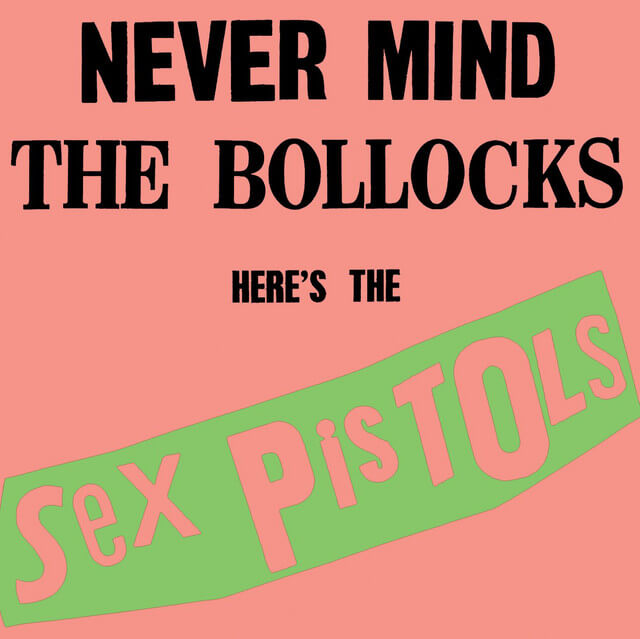 It would’ve been more shocking if the Pistols stuck around long enough to make a second LP. Every marketing gimmick has a shelf-life and the Pistols’ was particularly short. Bollocks is a musical Ouroboros, as its reputation has cycled from “dangerous salvation of rock ‘n’ roll” to “embarrassing cartoon” multiple times over since 1977. If you can ignore big sweeping statements and the misplaced notions of grandeur forced upon it you might be able to appreciate its relatively frills-free take on caustic rock ‘n’ roll recidivism. And hey, at least two people responsible were in on the joke, which is probably two more than The Police. —GM
It would’ve been more shocking if the Pistols stuck around long enough to make a second LP. Every marketing gimmick has a shelf-life and the Pistols’ was particularly short. Bollocks is a musical Ouroboros, as its reputation has cycled from “dangerous salvation of rock ‘n’ roll” to “embarrassing cartoon” multiple times over since 1977. If you can ignore big sweeping statements and the misplaced notions of grandeur forced upon it you might be able to appreciate its relatively frills-free take on caustic rock ‘n’ roll recidivism. And hey, at least two people responsible were in on the joke, which is probably two more than The Police. —GM
21. Tom Petty & The Heartbreakers: Tom Petty & The Heartbreakers (1976)

Tom Petty’s first record with The Heartbreakers isn’t the country rock masterpiece that Damn the Torpedoes and Hard Promises would become in the years after, but it’s still incredible. Spearheaded by the singular catchiness of “American Girl,” the Gainesville, Florida band would signify just how ready for the limelight they were. It doesn’t hurt that songs like “Breakdown” and “Anything That’s Rock ‘n’ Roll” would serve as longtime staples in measurements of Petty and The Heartbreakers’ enduring greatness. It’s always a gift to look at a debut 40 years after the fact and, in retrospect, see just how solid the roadmap to success was from the jump. Tom Petty & The Heartbreakers did just that. —MM
20. Big Star: #1 Record (1972)
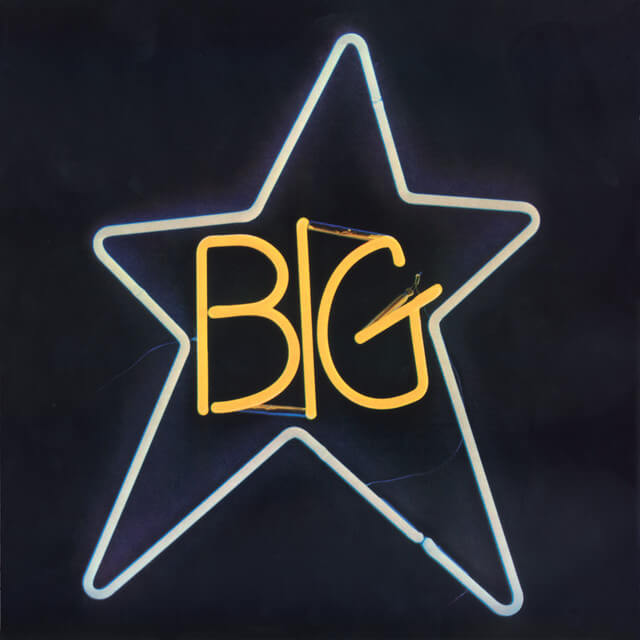 It takes a lot of gusto to name your debut album #1 Record, but when you’ve got it you’ve got it. Big Star broke through the Memphis scene they came up in and made a bonafide masterpiece right out of the gate. It was the first power pop album to really hone in on the groundwork The Who had laid down the decade prior, and you can feel just how magnetic the songs would remain for years to come. The singular balladry of “Thirteen,” the raucous, raw energy of “In the Street,” the magic of “The Ballad of El Goodo”—Alex Chilton, Chris Bell and company were on another level. #1 Record would go on to influence artists like The Replacements, R.E.M. and Nick Lowe and cement its place as the primitive power pop LP. They’d come roaring back two years later with Radio City, building on their already masterful oeuvre. —MM
It takes a lot of gusto to name your debut album #1 Record, but when you’ve got it you’ve got it. Big Star broke through the Memphis scene they came up in and made a bonafide masterpiece right out of the gate. It was the first power pop album to really hone in on the groundwork The Who had laid down the decade prior, and you can feel just how magnetic the songs would remain for years to come. The singular balladry of “Thirteen,” the raucous, raw energy of “In the Street,” the magic of “The Ballad of El Goodo”—Alex Chilton, Chris Bell and company were on another level. #1 Record would go on to influence artists like The Replacements, R.E.M. and Nick Lowe and cement its place as the primitive power pop LP. They’d come roaring back two years later with Radio City, building on their already masterful oeuvre. —MM
19. New York Dolls: New York Dolls (1973)
 Even now, 50 years on from its release, New York Dolls oozes with a sense of dread. Yes, there’s aggression, but there’s also an all-consuming anxiety as well—the feeling that invasion is imminent. The band are often the invaders, like on the aforementioned “Frankenstein,” a towering, propulsive shudder of a song that traces the path of outsiders swarming the city in search of excitement—only to find themselves still considered the freaks, still ostracized. While Johansen near-screeches “I’m gonna shout about it, bitch about it, scream about it, cry about it,” as that track reaches its fever pitch, he reverses roles completely on the prior track, “Lonely Planet Boy.” He coos along with a meandering saxophone line on an isolated, potentially obliterated city street. Even in its melancholy longing, there’s a disquiet to it—if he croons too loudly, the warped cymbals (which arrive near the track’s conclusion) will morph into an actual UFO and snatch him off the street. Even the invaders fear the outside invasion looming over otherwise straightforward tales of adolescent lust. —Elise Soutar
Even now, 50 years on from its release, New York Dolls oozes with a sense of dread. Yes, there’s aggression, but there’s also an all-consuming anxiety as well—the feeling that invasion is imminent. The band are often the invaders, like on the aforementioned “Frankenstein,” a towering, propulsive shudder of a song that traces the path of outsiders swarming the city in search of excitement—only to find themselves still considered the freaks, still ostracized. While Johansen near-screeches “I’m gonna shout about it, bitch about it, scream about it, cry about it,” as that track reaches its fever pitch, he reverses roles completely on the prior track, “Lonely Planet Boy.” He coos along with a meandering saxophone line on an isolated, potentially obliterated city street. Even in its melancholy longing, there’s a disquiet to it—if he croons too loudly, the warped cymbals (which arrive near the track’s conclusion) will morph into an actual UFO and snatch him off the street. Even the invaders fear the outside invasion looming over otherwise straightforward tales of adolescent lust. —Elise Soutar
-

-

-

-

-

-

-

-

-

-

-

-

-

-

-

-

-

-

-

-

-

-

-

-

-

-

-

-

-

-

-

-

-

-

-

-

-

-

-

-

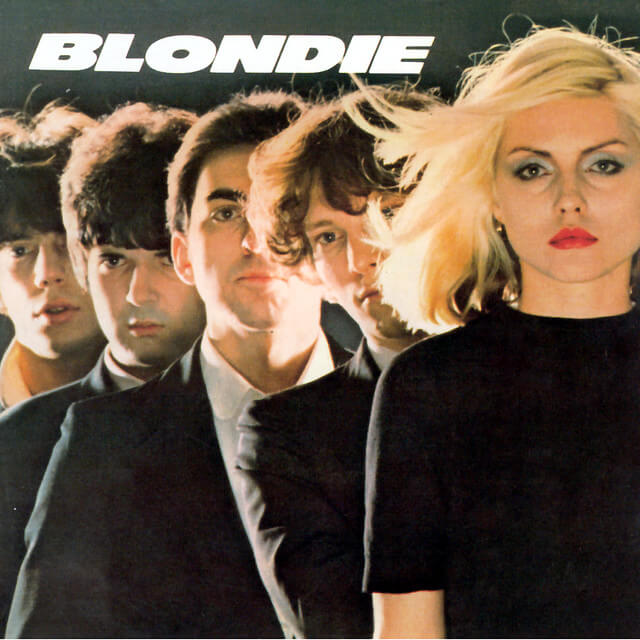
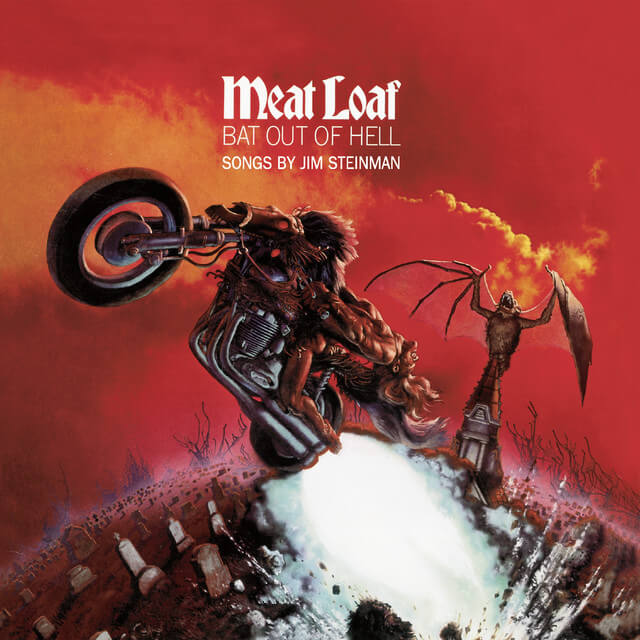 Meat Loaf had made a record with Shaun Murphy called Stoney and Meatloaf in 1971 on Motown’s Rare Earth subsidiary, but it wasn’t until 1977 that the Dallas-born vocalist would step out into his own collection of songs. When he linked up with songwriter Jim Steinman, the world was never the same—and their debut album together, Bat Out of Hell is one of the most memorable introductions in the history of rock ‘n’ roll altogether. Theatrical, campy and downright progressively enchanting, Bat Out of Hell is a delight from the title track all the way to “For Crying Out Loud.” It’s like watching a Broadway show unravel through a turntable, but with more gusto than an OST could ever muster. “Bat Out of Hell” has one of greatest earworm choruses of all time; “Paradise By the Dashboard Light” is so iconic its music video used to get played before showings of Rocky Horror Picture Show; “You Took the Words Right Out of My Mouth” and “Two Out of Three Ain’t Bad” are bold, rewarding ballads that showcase the echelons of Meat Loaf’s own vocal register. What a ridiculous, kooky and perfect album of strangeness. All hail Bat Out of Hell, the only thing in this world that is pure and good and right. —MM
Meat Loaf had made a record with Shaun Murphy called Stoney and Meatloaf in 1971 on Motown’s Rare Earth subsidiary, but it wasn’t until 1977 that the Dallas-born vocalist would step out into his own collection of songs. When he linked up with songwriter Jim Steinman, the world was never the same—and their debut album together, Bat Out of Hell is one of the most memorable introductions in the history of rock ‘n’ roll altogether. Theatrical, campy and downright progressively enchanting, Bat Out of Hell is a delight from the title track all the way to “For Crying Out Loud.” It’s like watching a Broadway show unravel through a turntable, but with more gusto than an OST could ever muster. “Bat Out of Hell” has one of greatest earworm choruses of all time; “Paradise By the Dashboard Light” is so iconic its music video used to get played before showings of Rocky Horror Picture Show; “You Took the Words Right Out of My Mouth” and “Two Out of Three Ain’t Bad” are bold, rewarding ballads that showcase the echelons of Meat Loaf’s own vocal register. What a ridiculous, kooky and perfect album of strangeness. All hail Bat Out of Hell, the only thing in this world that is pure and good and right. —MM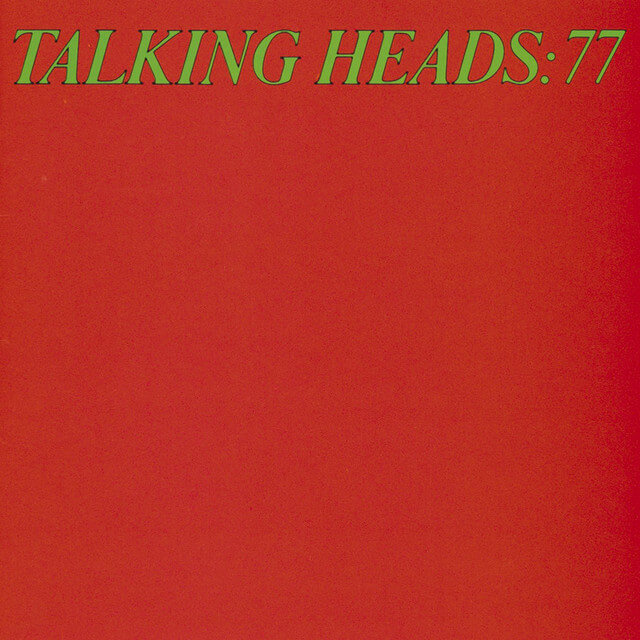 A part of New York’s CBGB dynasty, the Talking Heads were far from punk but carved a path all their own with Talking Heads ’77. The disjointed melodies and strained yelps of David Byrne gave the new wave group an almost alien feel. Their 11-track debut is filled with jerky rhythms that would be the perfect background music to “do the Elaine” to. The quartet’s most famous track, “Psycho Killer,” was the first they recorded vocals for on the album—what a way to kick off a music career. The snappy beat, Byrne’s stutter in the chorus and random addition of French lyrics are unmistakable—and a hell of a lot of fun. Who other than the Talking Heads could make a radio hit out of a song about a homicidal maniac? Although “Psycho Killer” is the album’s most successful track, people tend to overlook some of the hidden gems when talking about the Talking Heads, like “Don’t Worry About The Government.” This poppy, energetic track is a utopian dream: “My building has every convenience / It’s gonna make life easy for me / It’s gonna be easy to get things done / I will relax alone with my loved ones.” Its absurd optimism is highlighted by bouncy rhythms and Byrne’s high-pitched, bubbly vocals. Also, a highlight remains the unlikely love song, “Uh-Oh, Love Comes to Town,” asking what most of us wonder when we fall head over heels, “Where is my common sense?” It is the perfect opening track for their debut, embodying the best of the Talking Heads, Byrne’s anxious vocals, oblique lyrics, funky riffs and bouncy bass. Talking Heads ’77 is a swirl of primitive visions of a future that could only be funneled through the distinctive tones of Byrne and his beloved bandmates. —OA
A part of New York’s CBGB dynasty, the Talking Heads were far from punk but carved a path all their own with Talking Heads ’77. The disjointed melodies and strained yelps of David Byrne gave the new wave group an almost alien feel. Their 11-track debut is filled with jerky rhythms that would be the perfect background music to “do the Elaine” to. The quartet’s most famous track, “Psycho Killer,” was the first they recorded vocals for on the album—what a way to kick off a music career. The snappy beat, Byrne’s stutter in the chorus and random addition of French lyrics are unmistakable—and a hell of a lot of fun. Who other than the Talking Heads could make a radio hit out of a song about a homicidal maniac? Although “Psycho Killer” is the album’s most successful track, people tend to overlook some of the hidden gems when talking about the Talking Heads, like “Don’t Worry About The Government.” This poppy, energetic track is a utopian dream: “My building has every convenience / It’s gonna make life easy for me / It’s gonna be easy to get things done / I will relax alone with my loved ones.” Its absurd optimism is highlighted by bouncy rhythms and Byrne’s high-pitched, bubbly vocals. Also, a highlight remains the unlikely love song, “Uh-Oh, Love Comes to Town,” asking what most of us wonder when we fall head over heels, “Where is my common sense?” It is the perfect opening track for their debut, embodying the best of the Talking Heads, Byrne’s anxious vocals, oblique lyrics, funky riffs and bouncy bass. Talking Heads ’77 is a swirl of primitive visions of a future that could only be funneled through the distinctive tones of Byrne and his beloved bandmates. —OA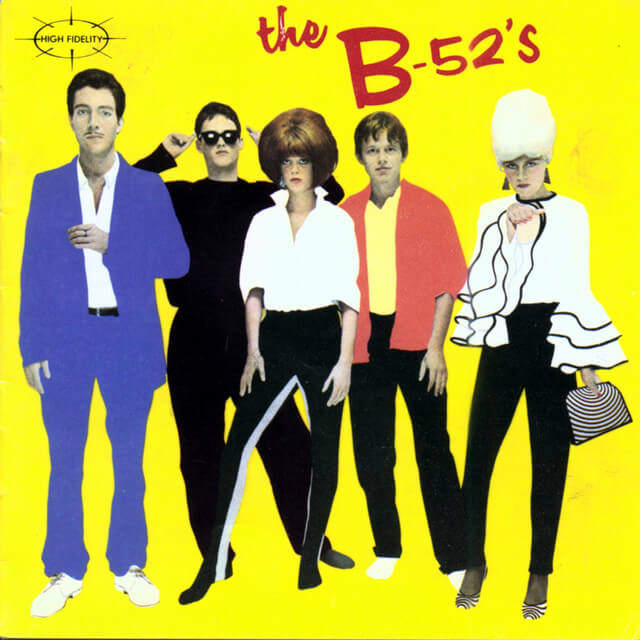 Growing up, I couldn’t make it through a single dance recital without seeing at least one “Love Shack” number with the stage covered in beach-themed items. I didn’t appreciate the cosmic wonder of The B-52’s until I rediscovered them on Just Dance 4 when I was 12. Yes, that’s right, my first experience with the new wave kitsch of The B-52’s was through dancing with an animated lobster in my parent’s house. If there is one thing I can say about this The B-52’s, it’s a party from start to finish. Opening with the morse-code beeps and a heist-movie-esque riff on “Planet Claire” cemented the space-age flair of these art punks. The B-52’s distinctive sound can be attributed to the talk-singing of Fred Schneider, the complimentary highs and lows of Kate Pierson’s and Cindy Wilson’s vocals and the unique tuning of Ricky Wilson’s riffs all of which are on display in “Dance This Mess Around.” You can’t talk about these trailblazers without mentioning “Hero Worship,” where Cindy’s raspy wails created what could be considered the very first riot grrrl song ever. Then you have the infamous “Rock Lobster” with Ricky’s funky and famous riff, a biting organ and a cacophony of animal sounds laced through a song about a rock that “wasn’t a rock.” It’s stupid fun, and its absurdity launched The B-52’s to the moon (in the sky.) —OA
Growing up, I couldn’t make it through a single dance recital without seeing at least one “Love Shack” number with the stage covered in beach-themed items. I didn’t appreciate the cosmic wonder of The B-52’s until I rediscovered them on Just Dance 4 when I was 12. Yes, that’s right, my first experience with the new wave kitsch of The B-52’s was through dancing with an animated lobster in my parent’s house. If there is one thing I can say about this The B-52’s, it’s a party from start to finish. Opening with the morse-code beeps and a heist-movie-esque riff on “Planet Claire” cemented the space-age flair of these art punks. The B-52’s distinctive sound can be attributed to the talk-singing of Fred Schneider, the complimentary highs and lows of Kate Pierson’s and Cindy Wilson’s vocals and the unique tuning of Ricky Wilson’s riffs all of which are on display in “Dance This Mess Around.” You can’t talk about these trailblazers without mentioning “Hero Worship,” where Cindy’s raspy wails created what could be considered the very first riot grrrl song ever. Then you have the infamous “Rock Lobster” with Ricky’s funky and famous riff, a biting organ and a cacophony of animal sounds laced through a song about a rock that “wasn’t a rock.” It’s stupid fun, and its absurdity launched The B-52’s to the moon (in the sky.) —OA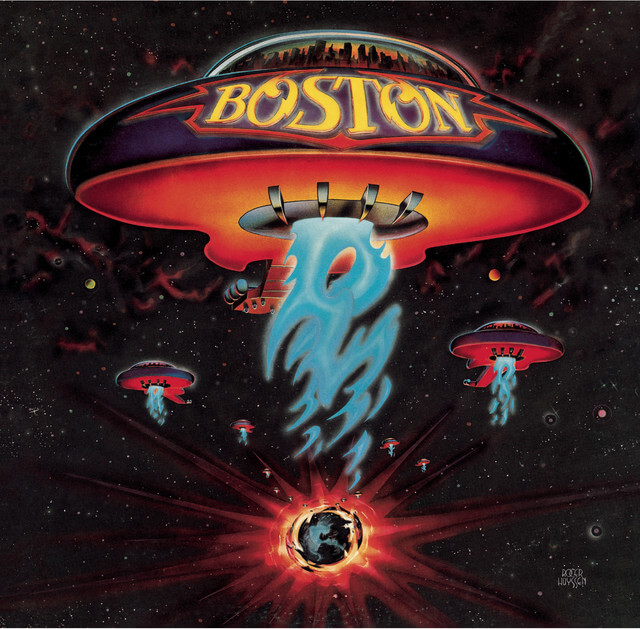 Few albums were as destined for greatness as the self-titled debut of Boston. The timing couldn’t have been more perfect. Led Zeppelin’s most recent album was a let down. Rush had helped introduce the larger world to a more commercial strain of prog rock. The radio airwaves were rife with boogie rock, folk-pop and warm vocal harmonies. And the country was awash with bicentennial madness. Swooping in was this group from Beantown who had polished every last second of their music into a gleam worthy of a freshly waxed muscle car. Every last processed guitar riff and sci-fi synth swoop was meticulously placed, and the high-tone vocals of Brad Delp sprung from it all like a waxy stem. The whole thing was bathed in a magic hour glow by band leader / producer Tom Scholz that instantly drew up memories of languid makeout sessions or stoned soul picnics or the kind of wood-paneled basements where the first iteration of this band knocked insta-classics like “More Than A Feeling” and “Hitch a Ride” into shape. Don’t let the faux humility of Scholz telling folks that he waited until the album had sold a few hundred thousand copies before he felt comfortable enough leaving his job at Polaroid fool you. He knew this was headed to the top of the charts and the rec room turntables of heshers around the U.S. They struck a cultural nerve that is still vibrating nearly 50 years later. —Robert Ham
Few albums were as destined for greatness as the self-titled debut of Boston. The timing couldn’t have been more perfect. Led Zeppelin’s most recent album was a let down. Rush had helped introduce the larger world to a more commercial strain of prog rock. The radio airwaves were rife with boogie rock, folk-pop and warm vocal harmonies. And the country was awash with bicentennial madness. Swooping in was this group from Beantown who had polished every last second of their music into a gleam worthy of a freshly waxed muscle car. Every last processed guitar riff and sci-fi synth swoop was meticulously placed, and the high-tone vocals of Brad Delp sprung from it all like a waxy stem. The whole thing was bathed in a magic hour glow by band leader / producer Tom Scholz that instantly drew up memories of languid makeout sessions or stoned soul picnics or the kind of wood-paneled basements where the first iteration of this band knocked insta-classics like “More Than A Feeling” and “Hitch a Ride” into shape. Don’t let the faux humility of Scholz telling folks that he waited until the album had sold a few hundred thousand copies before he felt comfortable enough leaving his job at Polaroid fool you. He knew this was headed to the top of the charts and the rec room turntables of heshers around the U.S. They struck a cultural nerve that is still vibrating nearly 50 years later. —Robert Ham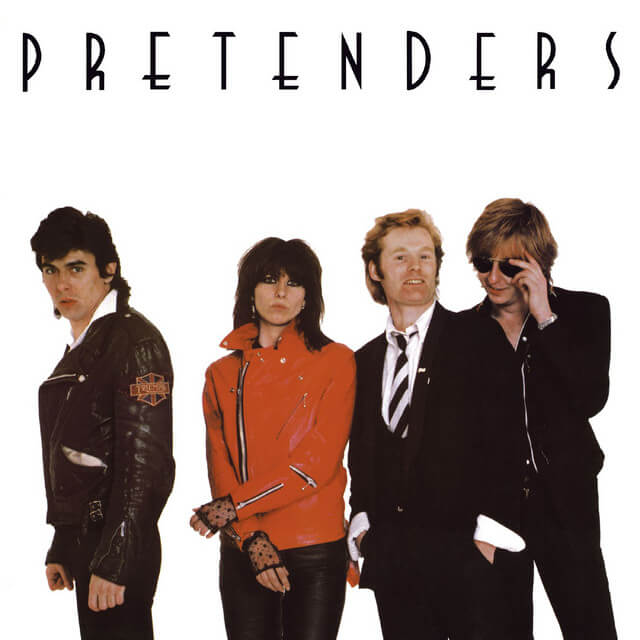 Merging the industrial brutalism of the Ohio Rust Belt with UK new wave rebellion was only going to work once, and The Pretenders were the first band to capture the flag. The band—a combination of Chrissie Hynde, Martin Chambers, Pete Farndon and James Honeyman-Scott—built the last great rock album of the 1970s, one packed to the brim with chart-worthy tunes like “Precious,” a Nick Lowe-produced cover of the Kinks’ “Stop Your Sobbing,” “Private Life,” “Kid” and, of course, “Brass in Pocket.” It was here where Hynde positioned herself as the foil to Blondie’s Debbie Harry, as one of the most important bandleaders in all of music. The work was innovative and culled influences of proto-punk, R&B and singer/songwriter, merging the forces together into one evocative, immersive benchmark of personal, astonishing rock ‘n’ roll that would make The Pretenders one of the most important bands throughout the next decade. —MM
Merging the industrial brutalism of the Ohio Rust Belt with UK new wave rebellion was only going to work once, and The Pretenders were the first band to capture the flag. The band—a combination of Chrissie Hynde, Martin Chambers, Pete Farndon and James Honeyman-Scott—built the last great rock album of the 1970s, one packed to the brim with chart-worthy tunes like “Precious,” a Nick Lowe-produced cover of the Kinks’ “Stop Your Sobbing,” “Private Life,” “Kid” and, of course, “Brass in Pocket.” It was here where Hynde positioned herself as the foil to Blondie’s Debbie Harry, as one of the most important bandleaders in all of music. The work was innovative and culled influences of proto-punk, R&B and singer/songwriter, merging the forces together into one evocative, immersive benchmark of personal, astonishing rock ‘n’ roll that would make The Pretenders one of the most important bands throughout the next decade. —MM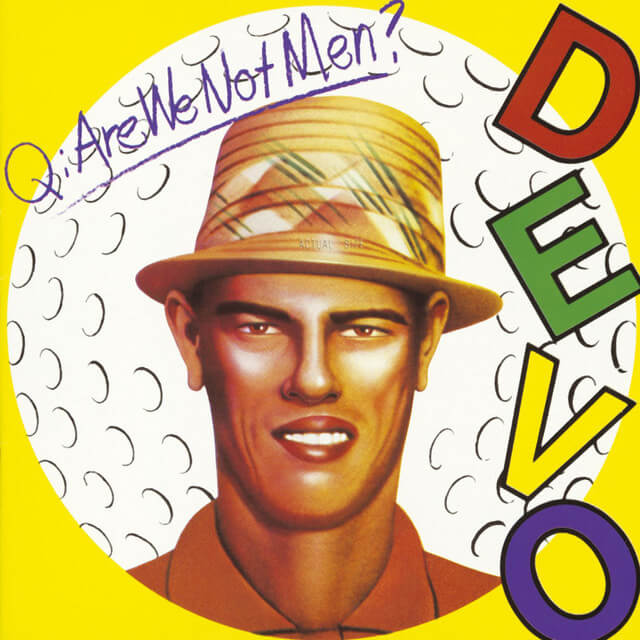 What happens when a couple of punks from Akron and Kent, Ohio band together and revolt against the propensities of the music industry? Well, you get Devo, of course. Started in 1973 by Mark Mothersbaugh and Gerald Casale, Devo had an almost mythical road to their debut record, Q. Are We Not Men? A. We Are Devo!. Casale and Bob Lewis were kicking around the idea of “devolution” while they were students at Kent State, and then the shootings happened on campus on May 4, 1970 and changed everything. They were programmed to systematically resist anything pop music was doing, and they turned their band into an art movement. Are We Not Men? boasts some of the most audacious songs of its era, including “Uncontrollable Urge,” “Jocko Homo” and, of course, Devo’s deconstruction of The Rolling Stones’ “(I Can’t Get No) Satisfaction.” They’d go from being mocked and pitied by right-wing, evangelical Ohioans to having Iggy Pop and David Bowie vouch for them to Warner Brothers to playing in front of 15-million people on Saturday Night Live before the end of 1978. What a trajectory, what a band—and the music industry is still trying to wrap its head around what the hell Devo were doing 45 years ago. —MM
What happens when a couple of punks from Akron and Kent, Ohio band together and revolt against the propensities of the music industry? Well, you get Devo, of course. Started in 1973 by Mark Mothersbaugh and Gerald Casale, Devo had an almost mythical road to their debut record, Q. Are We Not Men? A. We Are Devo!. Casale and Bob Lewis were kicking around the idea of “devolution” while they were students at Kent State, and then the shootings happened on campus on May 4, 1970 and changed everything. They were programmed to systematically resist anything pop music was doing, and they turned their band into an art movement. Are We Not Men? boasts some of the most audacious songs of its era, including “Uncontrollable Urge,” “Jocko Homo” and, of course, Devo’s deconstruction of The Rolling Stones’ “(I Can’t Get No) Satisfaction.” They’d go from being mocked and pitied by right-wing, evangelical Ohioans to having Iggy Pop and David Bowie vouch for them to Warner Brothers to playing in front of 15-million people on Saturday Night Live before the end of 1978. What a trajectory, what a band—and the music industry is still trying to wrap its head around what the hell Devo were doing 45 years ago. —MM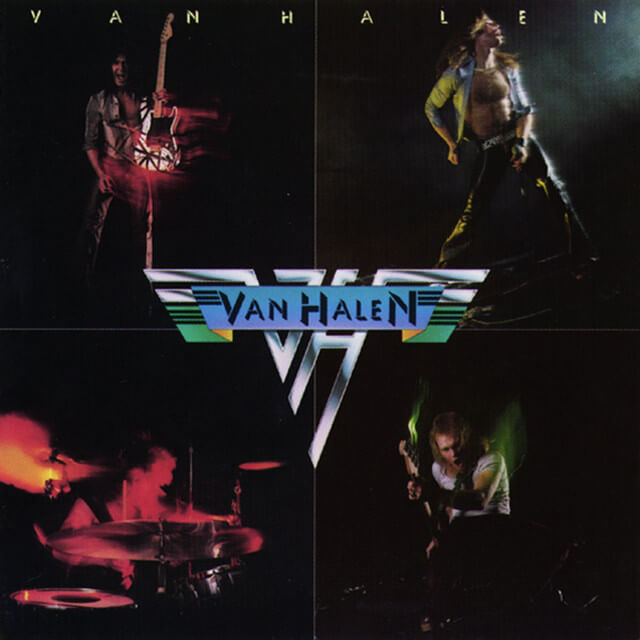 It can be easy to underscore the importance of Van Halen’s eponymous debut record, given that they were never the most primitive or marquee name working in rock ‘n’ roll. But, Van Halen is, to say the least, a perfect album packed to the brim with some of the most exciting and energetic rock tunes post-Beatles break-up. From their riotous, sensual cover of the Kinks’ “You Really Got Me” to the anthemic, blistering “Runnin’ with the Devil,” Van Halen pulled no punches when it came to stockpiling all of their hits and letting them unravel right out of the gates. “Ain’t Talkin’ Bout Love” is an underrated stunner that showcases David Lee Roth’s enigmatic frontman sensibilities, while Eddie Van Halen’s guitar solo “Eruption” is, perhaps, one of the greatest instrumental tracks in rock history. And we can’t forget about “Jamie’s Cryin’” and “Ice Cream Man.” Without Van Halen, glam and hair metal wouldn’t exist the way it does today—there would be no Appetite For Destruction or foil to mainstream pop. There’s an unquantifiable, daring magic here, and it’s what has made Van Halen a household name for nearly 50 years. —MM
It can be easy to underscore the importance of Van Halen’s eponymous debut record, given that they were never the most primitive or marquee name working in rock ‘n’ roll. But, Van Halen is, to say the least, a perfect album packed to the brim with some of the most exciting and energetic rock tunes post-Beatles break-up. From their riotous, sensual cover of the Kinks’ “You Really Got Me” to the anthemic, blistering “Runnin’ with the Devil,” Van Halen pulled no punches when it came to stockpiling all of their hits and letting them unravel right out of the gates. “Ain’t Talkin’ Bout Love” is an underrated stunner that showcases David Lee Roth’s enigmatic frontman sensibilities, while Eddie Van Halen’s guitar solo “Eruption” is, perhaps, one of the greatest instrumental tracks in rock history. And we can’t forget about “Jamie’s Cryin’” and “Ice Cream Man.” Without Van Halen, glam and hair metal wouldn’t exist the way it does today—there would be no Appetite For Destruction or foil to mainstream pop. There’s an unquantifiable, daring magic here, and it’s what has made Van Halen a household name for nearly 50 years. —MM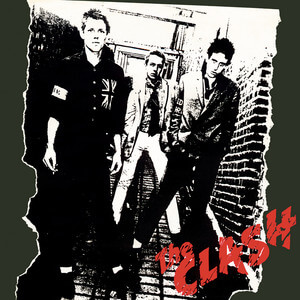 At the beginning of the 1970s, John Graham Mellor was, at various points, a gravedigger, a busker in the London Underground, a pinch-hitter vocalist and guitarist for bar bands. Then came the release of The Clash’s eponymous first album in ’77, a year associated forever with the explosion of punk rock. Mellor would become Joe Strummer and lead his band charging onto the scene with their debut, 35 minutes of pure energy, challenging the youth of Britain and the world to listen and to get up and dance (er, pogo). The Clash is an important reminder of how diverse the influences on the scene were, especially for a style of music that seems so simple. “Police & Thieves” recontextualizes the words of reggae greats Junior Murvin and Lee “Scratch” Perry; the harmonica and guitar fuzz on “Garageland” recalls the American R&B and early rock that Joe Strummer played in pubs when he was getting his start. But what stands out are the lean, guitar-driven howlers and sing-a-longs, like gleeful opener “Janie Jones,” “White Riot” and “I’m So Bored With the U.S.A.” Indeed, The Clash took their influences and environment and all the things that were pissing them off and turned it all into a riot of their own. —Lindsay Eanet
At the beginning of the 1970s, John Graham Mellor was, at various points, a gravedigger, a busker in the London Underground, a pinch-hitter vocalist and guitarist for bar bands. Then came the release of The Clash’s eponymous first album in ’77, a year associated forever with the explosion of punk rock. Mellor would become Joe Strummer and lead his band charging onto the scene with their debut, 35 minutes of pure energy, challenging the youth of Britain and the world to listen and to get up and dance (er, pogo). The Clash is an important reminder of how diverse the influences on the scene were, especially for a style of music that seems so simple. “Police & Thieves” recontextualizes the words of reggae greats Junior Murvin and Lee “Scratch” Perry; the harmonica and guitar fuzz on “Garageland” recalls the American R&B and early rock that Joe Strummer played in pubs when he was getting his start. But what stands out are the lean, guitar-driven howlers and sing-a-longs, like gleeful opener “Janie Jones,” “White Riot” and “I’m So Bored With the U.S.A.” Indeed, The Clash took their influences and environment and all the things that were pissing them off and turned it all into a riot of their own. —Lindsay Eanet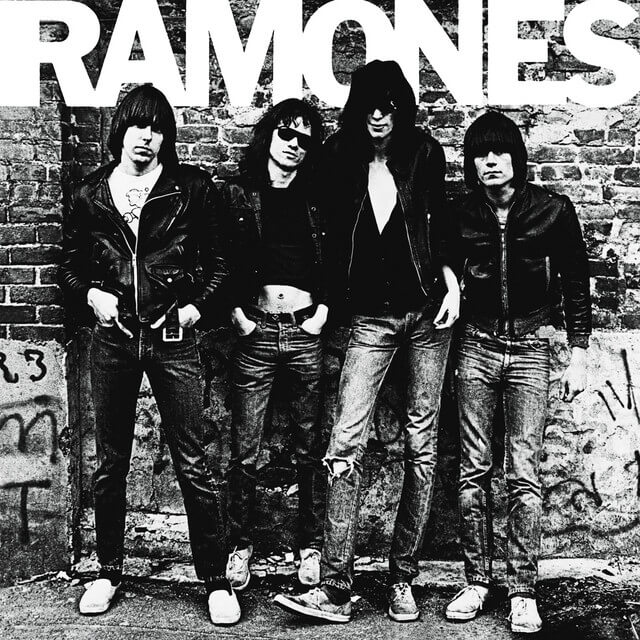 The Rosetta stone of punk rock came together in a blur. A week-long recording session wherein all the instrumental tracks were knocked out in a few days and the vocals were kicked down in a few more. Sure, that speaks to the boneheaded three chords and a dream truth behind the quartet and the amount of time that they had to hone their arrow-like trajectory while dominating the underground clubs of New York. Yet it still feels bold for an era of major label, arena rock bloat and overproduced palaver that was all over the airwaves. What the Ramones had to offer was rock music stripped down and lean, inspired by the hooky radio hits of Phil Spector and the Beatles but not beholden to it. They understood the structures of pop songcraft but were young and steamed up enough to use it as a canvas on which to paint scenes from their favorite horror films, real-life scenes from the grimy streets of downtown New York and valentines to potential partners rendered in garish colors. The snotty and the sweet presented in one under-30 minute speed trip. —RH
The Rosetta stone of punk rock came together in a blur. A week-long recording session wherein all the instrumental tracks were knocked out in a few days and the vocals were kicked down in a few more. Sure, that speaks to the boneheaded three chords and a dream truth behind the quartet and the amount of time that they had to hone their arrow-like trajectory while dominating the underground clubs of New York. Yet it still feels bold for an era of major label, arena rock bloat and overproduced palaver that was all over the airwaves. What the Ramones had to offer was rock music stripped down and lean, inspired by the hooky radio hits of Phil Spector and the Beatles but not beholden to it. They understood the structures of pop songcraft but were young and steamed up enough to use it as a canvas on which to paint scenes from their favorite horror films, real-life scenes from the grimy streets of downtown New York and valentines to potential partners rendered in garish colors. The snotty and the sweet presented in one under-30 minute speed trip. —RH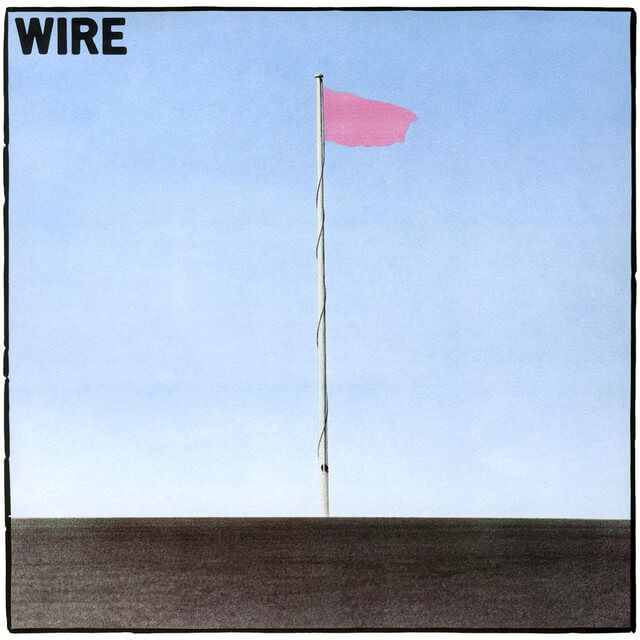 Wire’s Pink Flag is a fragmented, pulverizing reflection of the brash explosion that was punk; a stock measurement of its particular place in time, and moving the genre’s ethos into an increasingly more expressive future. Call it art-school punk; call it the first post-punk album—whatever moniker you give it would probably be incomplete, as articulating the novelty of what Wire accomplished on their debut is no easy task. Rather than stalling and taking their time to unravel, these tracks bounce in and out with such an urgency that refuses to let you settle into even the most straightforward of their grooves. The longest track by far clocks in at just under four minutes; the shorter ones burn out before even the one-minute mark. For all of its restless brevity, Pink Flag is impossible to pin down. Once you figure out the poppy structure of a song like “Mannequin,” the group hits you with the torrid “Different to Me,” more of a 43-second writhing of sound than anything that resembles a traditional verse/chorus/verse song. Hell, the dirty melody that makes up the track “Strange” features a flute arrangement—albeit a dissonant, industrial sounding one that sounds more like a howl than any sort of whistling. Pink Flag was, simultaneously, the crumbling of the punk movement’s walls and its inevitable consequent; Wire’s angular weirdness paved the way for decades of acts making noise in the aftermath of punk with an uncanny clairvoyance. —MD
Wire’s Pink Flag is a fragmented, pulverizing reflection of the brash explosion that was punk; a stock measurement of its particular place in time, and moving the genre’s ethos into an increasingly more expressive future. Call it art-school punk; call it the first post-punk album—whatever moniker you give it would probably be incomplete, as articulating the novelty of what Wire accomplished on their debut is no easy task. Rather than stalling and taking their time to unravel, these tracks bounce in and out with such an urgency that refuses to let you settle into even the most straightforward of their grooves. The longest track by far clocks in at just under four minutes; the shorter ones burn out before even the one-minute mark. For all of its restless brevity, Pink Flag is impossible to pin down. Once you figure out the poppy structure of a song like “Mannequin,” the group hits you with the torrid “Different to Me,” more of a 43-second writhing of sound than anything that resembles a traditional verse/chorus/verse song. Hell, the dirty melody that makes up the track “Strange” features a flute arrangement—albeit a dissonant, industrial sounding one that sounds more like a howl than any sort of whistling. Pink Flag was, simultaneously, the crumbling of the punk movement’s walls and its inevitable consequent; Wire’s angular weirdness paved the way for decades of acts making noise in the aftermath of punk with an uncanny clairvoyance. —MD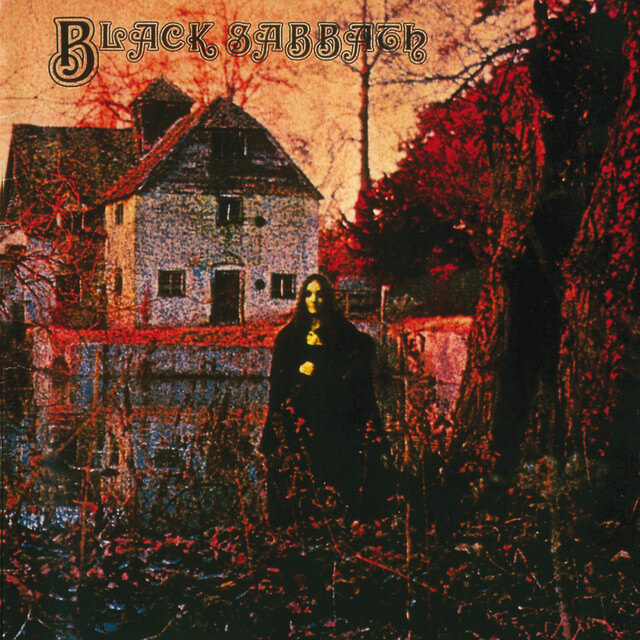 If we
If we 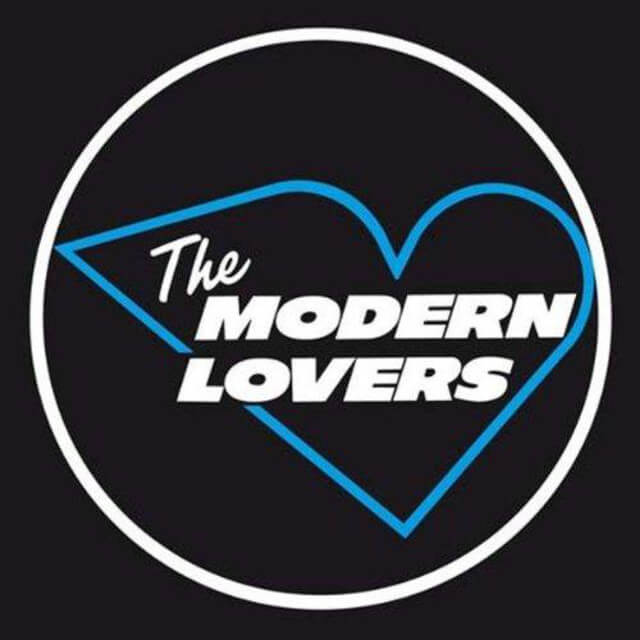 It begins with a casual yet insistent countdown. A voice that jumps out, not with a Ramones-esque four count but with an off-kilter six count that puts listeners dead center into the first bar of the first song, a rollicking, Velvets-inspired joyride down the Mass Turnpike with the windows and the radio on. The next four minutes and the 30 that follow for the most part maintain a similar pace, at cruising altitude and top speed as the fang-free leader Jonathan Richman invites folks to meet him on an astral plane, wonders why he can’t be as cool as Pablo Picasso and kindly spells out what he’s looking for in this modern world (a girlfriend). For decades now, a varying cast of characters has been riding shotgun and listening closely to Richman and the gang. What has followed is a cavalcade of jangle pop groups, punk bands and college rockers. Not a bad way to go for a group that recorded these tracks years earlier and had broken up by the time they were released. A pebble dropped into the pre-punk world that is still sending ripples of joy and inspiration into the known universe. —RH
It begins with a casual yet insistent countdown. A voice that jumps out, not with a Ramones-esque four count but with an off-kilter six count that puts listeners dead center into the first bar of the first song, a rollicking, Velvets-inspired joyride down the Mass Turnpike with the windows and the radio on. The next four minutes and the 30 that follow for the most part maintain a similar pace, at cruising altitude and top speed as the fang-free leader Jonathan Richman invites folks to meet him on an astral plane, wonders why he can’t be as cool as Pablo Picasso and kindly spells out what he’s looking for in this modern world (a girlfriend). For decades now, a varying cast of characters has been riding shotgun and listening closely to Richman and the gang. What has followed is a cavalcade of jangle pop groups, punk bands and college rockers. Not a bad way to go for a group that recorded these tracks years earlier and had broken up by the time they were released. A pebble dropped into the pre-punk world that is still sending ripples of joy and inspiration into the known universe. —RH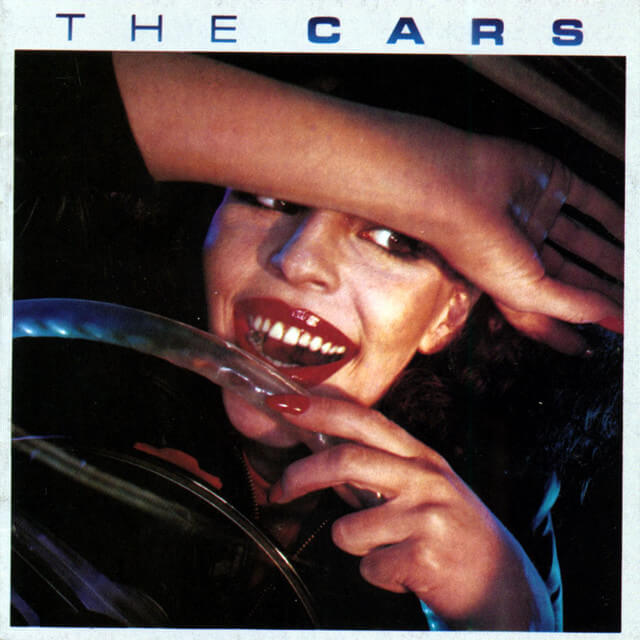 When the Paste team began debating on the order of this list, there was one thing we agreed on immediately: The tracklist of The Cars’ eponymous debut album is stacked from front-to-back. There is, quite possibly, no greater nine-song run to start a record—“Good Times Roll,” “My Best Friend’s Girl,” “Just What I Needed,” “I’m In Touch With Your World,” “Don’t Cha Stop” and “You’re All I’ve Got Tonight” in succession is maddening. But then, to plump the back-end of side two with “Bye Bye Love,” “Moving in Stereo” and “All Mixed Up”? Ric Ocasek, Benjamin Orr and the boys were de-facto mad scientists for drumming up such an unthinkable first chapter for themselves as a band. I don’t even feel the urge to try and convince you about whether or not The Cars have earned this place; the songs speak for themselves and endure as benchmarks of the grey area caught between new wave and post-punk. The band would continue to make hits well into the 1980s, but nothing breaks or bends the perfection and mastery they exhibited across their debut. —MM
When the Paste team began debating on the order of this list, there was one thing we agreed on immediately: The tracklist of The Cars’ eponymous debut album is stacked from front-to-back. There is, quite possibly, no greater nine-song run to start a record—“Good Times Roll,” “My Best Friend’s Girl,” “Just What I Needed,” “I’m In Touch With Your World,” “Don’t Cha Stop” and “You’re All I’ve Got Tonight” in succession is maddening. But then, to plump the back-end of side two with “Bye Bye Love,” “Moving in Stereo” and “All Mixed Up”? Ric Ocasek, Benjamin Orr and the boys were de-facto mad scientists for drumming up such an unthinkable first chapter for themselves as a band. I don’t even feel the urge to try and convince you about whether or not The Cars have earned this place; the songs speak for themselves and endure as benchmarks of the grey area caught between new wave and post-punk. The band would continue to make hits well into the 1980s, but nothing breaks or bends the perfection and mastery they exhibited across their debut. —MM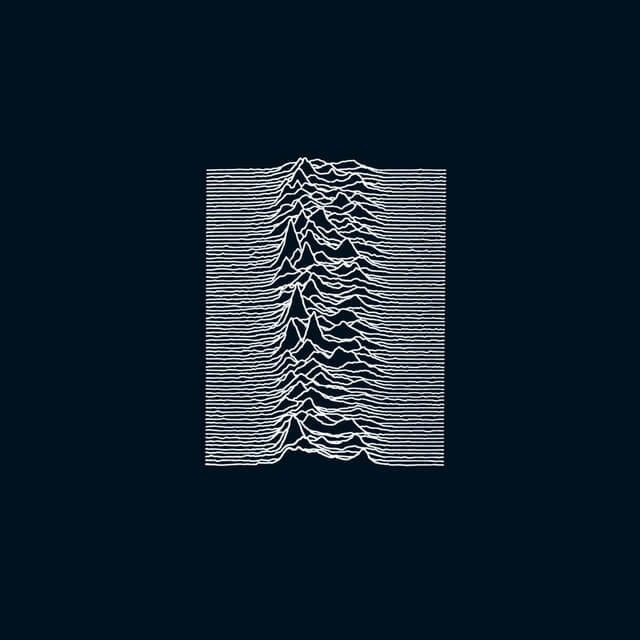 The most recognizable album cover post-Dark Side of the Moon, Joy Division’s Unknown Pleasures continues to find audiences—in some way or another—in 2023. The work of Ian Curtis, Bernard Sumner, Peter Hook and Stephen Morris was just a stepping stone for what direction post-punk and new wave could take. The results are sometimes menacing, as Curtis’ deadpan delivery on songs like “Disorder” and “Shadowplay” are haunting and stirring. Other cuts, like “She’s Lost Control” and “Wilderness” exude gothic tones and hues, as Joy Division primed themselves to become one of England’s greatest bands. It’s hard to know what might have come of the band had Curtis lived beyond 1980, but I’d like to think that Joy Division was on a crash-course for the heights and reverence that The Smiths would get four years later. Of course, New Order would arise from the ashes of Unknown Pleasures and Closer, but the groundwork laid by Curtis and his bandmates in 1979 can still be felt 44 years later. It’s a perfect album that continues to influence groups like Fontaines D.C., shame and Yard Act. —MM
The most recognizable album cover post-Dark Side of the Moon, Joy Division’s Unknown Pleasures continues to find audiences—in some way or another—in 2023. The work of Ian Curtis, Bernard Sumner, Peter Hook and Stephen Morris was just a stepping stone for what direction post-punk and new wave could take. The results are sometimes menacing, as Curtis’ deadpan delivery on songs like “Disorder” and “Shadowplay” are haunting and stirring. Other cuts, like “She’s Lost Control” and “Wilderness” exude gothic tones and hues, as Joy Division primed themselves to become one of England’s greatest bands. It’s hard to know what might have come of the band had Curtis lived beyond 1980, but I’d like to think that Joy Division was on a crash-course for the heights and reverence that The Smiths would get four years later. Of course, New Order would arise from the ashes of Unknown Pleasures and Closer, but the groundwork laid by Curtis and his bandmates in 1979 can still be felt 44 years later. It’s a perfect album that continues to influence groups like Fontaines D.C., shame and Yard Act. —MM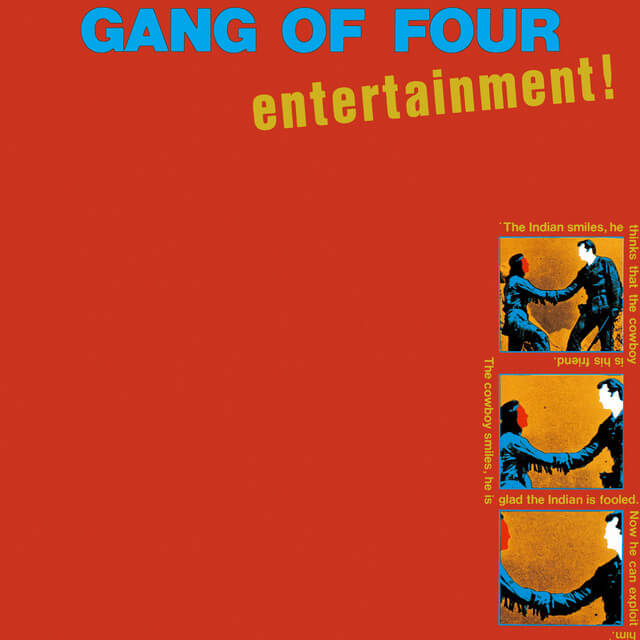 All our modern post-punk roads lead back to this starting point. Reared on a diet of Marxist tracts, the slashing guitar playing of Dr. Feelgood’s Wilko Johnson, disco and Krautock, four young men from Leeds set the course for generations of artists by winding together this taut, lacerating masterpiece. The connective tissue that they discovered within all of those influences was the power of repetition. Singer Jon King circled back on the same phrases throughout his lyrics while drummer Hugo Barnham and bassist Dave Allen had a collective understanding of the hypnotic power of locking into a singular groove. The X-factor throughout was Andy Gill, a guitarist whose tone was as corrosive and sharp as a rusting spool of barbed wire. With their collective power and force of will, the four were able to drill down to the core of still-simmering issues like capitalism, the Great Man Theory, media manipulation and sexual politics. Few albums from this era remain as prescient and as influential. —RH
All our modern post-punk roads lead back to this starting point. Reared on a diet of Marxist tracts, the slashing guitar playing of Dr. Feelgood’s Wilko Johnson, disco and Krautock, four young men from Leeds set the course for generations of artists by winding together this taut, lacerating masterpiece. The connective tissue that they discovered within all of those influences was the power of repetition. Singer Jon King circled back on the same phrases throughout his lyrics while drummer Hugo Barnham and bassist Dave Allen had a collective understanding of the hypnotic power of locking into a singular groove. The X-factor throughout was Andy Gill, a guitarist whose tone was as corrosive and sharp as a rusting spool of barbed wire. With their collective power and force of will, the four were able to drill down to the core of still-simmering issues like capitalism, the Great Man Theory, media manipulation and sexual politics. Few albums from this era remain as prescient and as influential. —RH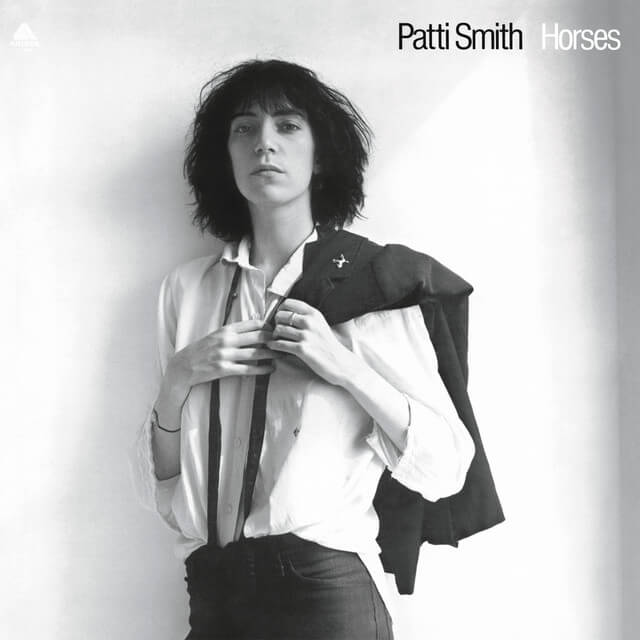 In 1975, Patti Smith wasn’t just starting out. She had schlepped it up to New York in the late ’60s, poked around enough in the art world as the ’70s began and, by ’74, was a mainstay at the East Village’s CBGB. Horses was Smith’s assertion of herself and her place in a musical world that was changing more rapidly than anyone could keep track of. Smith’s debut was a rather deft one—she could see exactly where she was along this timeline, and she wrote incisively, poetically and honestly about that. “Psychologically, somewhere in our hearts, we were all screwed up because those people died,” she said of the rapid loss of many of the 60s’ most innovative, free spirited musicians. “We all had to pull ourselves together. To me, that’s why our record is called Horses. We had to pull the reins on ourselves to recharge ourselves… We’re ready to start moving again.”
In 1975, Patti Smith wasn’t just starting out. She had schlepped it up to New York in the late ’60s, poked around enough in the art world as the ’70s began and, by ’74, was a mainstay at the East Village’s CBGB. Horses was Smith’s assertion of herself and her place in a musical world that was changing more rapidly than anyone could keep track of. Smith’s debut was a rather deft one—she could see exactly where she was along this timeline, and she wrote incisively, poetically and honestly about that. “Psychologically, somewhere in our hearts, we were all screwed up because those people died,” she said of the rapid loss of many of the 60s’ most innovative, free spirited musicians. “We all had to pull ourselves together. To me, that’s why our record is called Horses. We had to pull the reins on ourselves to recharge ourselves… We’re ready to start moving again.”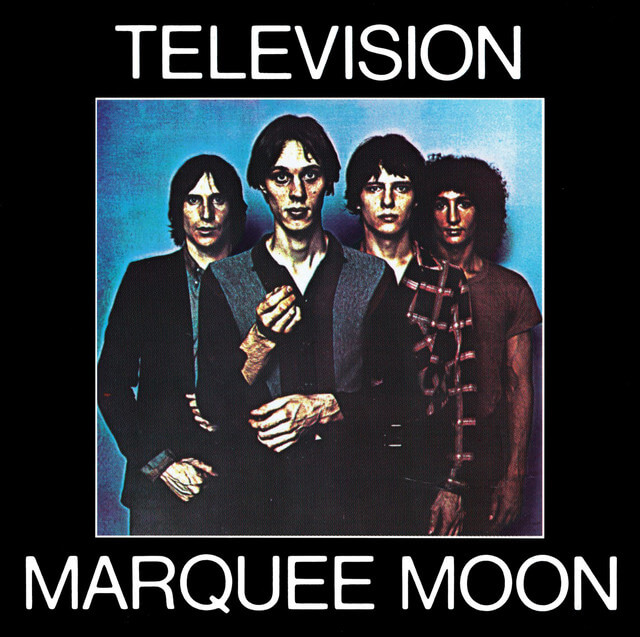 Around the time of the album’s 40th anniversary of Television’s peerless debut album Marquee Moon, guitarist Richard Lloyd told Consequence, “It’s been on top 10 lists and top 50 lists and top 100 lists, and I hope it stays on those lists.” Placing it at the top of this particular list may then feel like just another accolade to throw atop an already teetering pile of praise and wonderment for this nearly 50-year-old LP. But there are few albums capable of shouldering that load. When it arrived in the world amid a head-spinning run of releases (out the same month as Marquee Moon: Rumours, Damned Damned Damned, Peter Gabriel’s first solo album, the first Cheap Trick record and The Saints’ (I’m) Stranded), the record couldn’t help but rise above the fray like leader Tom Verlaine’s lanky body popping out amid a sea of bodies at CBGB’s or Max’s Kansas City.
Around the time of the album’s 40th anniversary of Television’s peerless debut album Marquee Moon, guitarist Richard Lloyd told Consequence, “It’s been on top 10 lists and top 50 lists and top 100 lists, and I hope it stays on those lists.” Placing it at the top of this particular list may then feel like just another accolade to throw atop an already teetering pile of praise and wonderment for this nearly 50-year-old LP. But there are few albums capable of shouldering that load. When it arrived in the world amid a head-spinning run of releases (out the same month as Marquee Moon: Rumours, Damned Damned Damned, Peter Gabriel’s first solo album, the first Cheap Trick record and The Saints’ (I’m) Stranded), the record couldn’t help but rise above the fray like leader Tom Verlaine’s lanky body popping out amid a sea of bodies at CBGB’s or Max’s Kansas City.






































